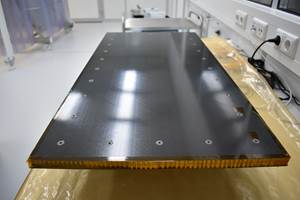Lockheed Martin completes Orion development for Artemis II
Upgraded composite spacecraft has been delivered to NASA for final preparations for the 2026 launch that, unlike the Artemis I mission, will be crewed.
As of May 1, Lockheed Martin (Bethesda, Md., U.S.) has completed assembly and testing of NASA’s (Washington, D.C., U.S.) Orion Artemis II spacecraft, transferring possession to NASA’s Exploration Ground Systems (EGS) team today. The milestone is another step in the program as NASA prepares to launch a crew of four astronauts to further the agency's mission in establishing a human presence on the moon for exploration and scientific discovery. It will also help build the foundation for the first crewed missions to Mars.
Uncrewed EFT-1 and Artemis I test flights were the first steps in validating the spacecraft’s core systems. Artemis II will put Orion through its final tests in deep space with a crew on board and will include learnings and significant enhancements gleaned from the Artemis I mission.
To support the health and safety of the crew, new systems have been added, which include life support — air, water, thermal control, waste management — displays and controls, audio communications, an exercise machine and a fully functional launch abort system. Additionally, the vehicle is outfitted with a subset of docking sensors and an experimental laser communication system, enabling high data-rate communications and paving the way for future missions.
With the completion of Orion, the EGS team will perform final preparations on the spacecraft, readying it for launch. Orion will soon be moved from the Neil Armstrong Operations and Checkout Building at NASA’s Kennedy Space Center to various processing facilities. This is where EGS will load propellants and other consumables, such as water and oxygen, and install the launch abort system and its protective fairings. Upon completion, it will then be transported to the Vehicle Assembly Building, lifted onto the SLS rocket and undergo final preparations for launch.
Scheduled to launch in early 2026, Artemis II and the Orion spacecraft will host NASA astronauts Reid Wiseman, Victor Glover, Christina Koch and Canadian astronaut Jeremy Hansen. Their 10-day journey will include flying 4,600 miles beyond the Moon and back to Earth.
During the mission, the crew will evaluate the spacecraft's performance, test its navigation and communication systems, and conduct a series of scientific experiments. They will perform a rendezvous operation with the SLS upper stage, practicing docking activities needed for future missions including Artemis III — which will mark the first human lunar landing since Apollo 17 in 1972.
With work on Orion for Artemis II completed, Lockheed Martin continues to develop and assemble Orion spacecraft for future Artemis missions. Artemis III and IV vehicles are in the Operations and Checkout Building, while the pressure vessel is being welded at NASA’s Michoud Facility in New Orleans. Lockheed Martin is on contract to develop Orion spacecraft up to Artemis VIII and has decreased cost with each vehicle.
Related Content
Composites end markets: New space (2025)
Composite materials — with their unmatched strength-to-weight ratio, durability in extreme environments and design versatility — are at the heart of innovations in satellites, propulsion systems and lunar exploration vehicles, propelling the space economy toward a $1.8 trillion future.
Read MoreLow-cost, efficient CFRP anisogrid lattice structures
CIRA uses patented parallel winding, dry fiber, silicone tooling and resin infusion to cut labor for lightweight, heavily loaded space applications.
Read MoreNanomaterials optimize performance of space-ready carbon fiber composite panels
A recent ESA project led by Adamant Composites aimed to mature nanomaterial-enhanced CFRP for lighter weight, more thermally and electrically conductive materials for manufacturing satellite structures.
Read MoreOrbital Composites wins award from U.S. Space Force to build space factories for antennas
Partners Axiom Space, Northrop Grumman Space Logistics and Southwest Research Institute will help advance ISAM technologies for kilometer-scale LEO antennas, space stations and GEO applications, targeting space factory in 3-5 years.
Read MoreRead Next
Scorpius Type 5 tanks underpin second Intuitive Machines mission to the moon
IM-2 mission launch of Nova-C class lander on March 6 features composite propulsion system infrastructure that will enable successful lunar touchdown, exploration.
Read MoreFirefly Aerospace successfully completes 14 days of surface operations on the Moon
Longest commercial Moon mission using Firefly’s composites-intensive Blue Ghost lander completes more than 346 hours of surface operations, transmitting more than 119 gigabytes of data back to Earth.
Read MoreIntuitive Machines debuts moon buggy for Artemis program
IM’s Moon RACER is one of three lunar terrain vehicle (LTV) designs being considered by NASA for future operations on the lunar surface.
Read More



























